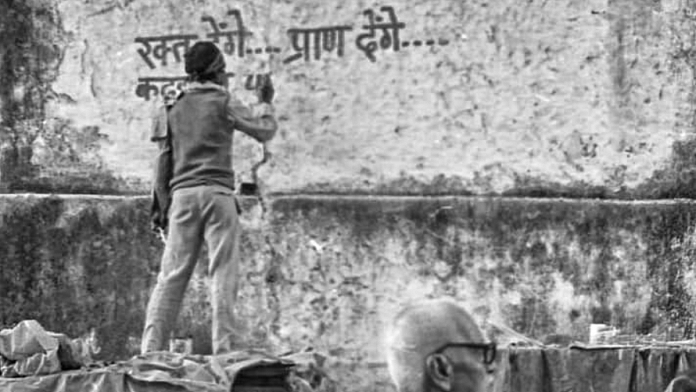Thank you dear subscribers, we are overwhelmed with your response.
Your Turn is a unique section from ThePrint featuring points of view from its subscribers. If you are a subscriber, have a point of view, please send it to us. If not, do subscribe here: https://englishdev.theprint.in/subscribe/
Mainly, the Indian political landscape is at an intersection of liberal democracy and religious populism, with Hindutva politics redefining spaces of religious and not merely cultural significance, such as Mathura and Kashi after Ayodhya. Reclaiming Hindu heritage is a traditional pursuit of Hindutva politics. It can be seen in the BJP’s political stratagem to claim controversial religious spaces (post-Babri) and lace them with national interests. Internationally, PM Modi has sought to augment and exhibit Hindu heritage in the form of new mandirs constructed abroad, from the UAE to the USA (most recently the BAPS Swaminarayan Mandir in Abu Dhabi). With general elections close by, the mainstream political discourse in India is mired in ‘a tug of war’ between Hindutva politics and ‘the sundry opposition’ who comprise the INDI alliance. There’s going to be an electoral churn again in the upcoming general elections. It’s a watershed moment for Indian politics; in the BJP and NDA, it remains to be seen whether it’s ‘theo-political Hindutva’ or ‘political conservatism’ that defines its future. In Uttar Pradesh (UP), it’s different; rather, the Yogi-led BJP in UP has explicitly stated its desire to channelize the religious sentiments of Indians towards Gyanvapi and Shahi Idgah (sub judice). Politically, it’s another chapter for Hindutva; in Uttar Pradesh, the ground’s ready for another round of ‘Kar Seva’?
Theopolitics: Hindutva & Muslims
What has changed since the demolition of Babri Mosque (1992)? And what can we expect from Mathura and Kashi? Given the religious sentiments associated with contended religious spaces in Mathura and Kashi (Gyanvapi and Shahi Idgah), the Muslim litigants have two options: either prepare for a long legal tussle to reclaim the Gyanvapi Mosque and Shahi Idgah or accede to the Hindutva’s demand. When UP CM Yogi Adityanath made an emotional pitch for Gyanvapi and Shahi Idgah in his UP Vidhan Sabha speech (on February 7, 2024), He invoked the ‘Mahabharata Epic’ and commented on the religious vanity of Duryodhan (the villain); he said, “At that time, Krishna went to the Kauravas and sought only five villages. Keep the rest to yourself, Krishna told them. Duryodhan woh bhi de na saka, Ashish samaj ki le na saka…”. He found similitude in the opposition from Muslims to claims by the Hindu litigants with the arrogance of Duryodhan, who opposed the Dharma and the Pandavas. Here, politics meets theology, and it becomes ‘theopolitics’. What has changed since the Babri demolition? When was Babri Mosque demolished (6 December 1992) by the Kar Sevaks? It was long before the 9/11 attacks and the US-led military campaign (open and covert) against Jihadism, referred to as the ‘War on Terror’. The results of which are apparent today, with nation-states altered, diminished, and revised in many countries such as Iraq, Afghanistan, Libya, and Syria, most notably after the revolutions that struck the Arab World. Peace and stability remain a scarcity, and the world is more anarchic than before. A similar contention surrounding religious spaces resonates with the Jerusalem complex. Although it’s a fallacy to compare the two scenarios, where Israeli-Palestinian conflict is more complex than the status quo of the Jerusalem complex, it’s more about a Palestinian state and ethnic reconciliation, which seem far-fetched now. Israel also has a 21% Arab citizenry, who are electoral stakeholders in Israeli politics; the majority of them are Muslims.
India and the Muslim question
India has intermittently suffered from communal conflicts, since 1992; particularly due to disputes surrounding religious spaces such as madrassas, mosques, dargahs, and temples. For instance, in the recent Haldwani violence, the disputed property was reportedly a madrassa. glaring loss of life and property, Muslims suffered fatalities, and police personnel suffered severe injuries. In the absence of mechanisms for communal reconciliation, such confrontations remain likely. Rather, conflict resolution and mechanisms are scarce and limited to the judiciary. Indian society at the grassroots level is once again mired in regressive politics of ‘identity, space, and communalism’ especially in Uttar Pradesh and Uttarakhand. Given the trajectory of Hindutva politics, its epitome is not settled yet, where Yogi Adityanath (CM UP) offers a new brand of Hindutva that is more charged than the Modi brand. It is theopolitics and not merely Hindutva politics (populism in India) that emerge from UP. For those who value minority rights’ and for Indian Islamic heritage, especially the dejected Jamiat Ulema e Hind, it would be politically and religiously prudent to arrive at a consensus involving the Mandir claimants, who ask for Gyanvapi Mosque and Shahi Idgah ‘only’ as per CM Yogi Adityanath, to settle the feud that he juxtaposed with the Mahabharata epic. So, what about Nandi Bull facing Gyanvapi? Isn’t it akin to ‘the Samiri’s bull’ that divided the people of Moses and dismayed Prophet Moses and Sri Ram s/o Dashrath has a namesake in the Hebrew Bible as Ram s/o of Hezron.
These pieces are being published as they have been received – they have not been edited/fact-checked by ThePrint.


